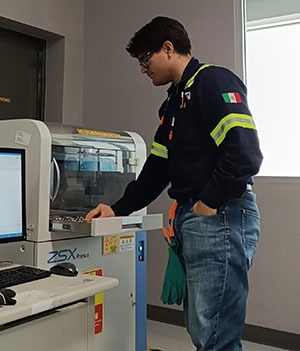AIST Foundation Steel Intern Scholarship
 Emmanuel Lozano Maldonado
Emmanuel Lozano Maldonado
My project consisted in the construction of a calibration curve for an X-ray fluorescence spectroscopy (XRF) equipment, to measure the chemical composition of zinc alloy. The objective was to migrate from the current analysis method, which is performed by inductively coupled plasma spectroscopy (ICP), to XRF analysis.
This migration responds to the need to reduce the consumption of time and materials; XRF analysis does not require consumables or invasive processes compared to ICP analysis, which requires acids, water and mechanical drilling, which makes XRF analysis a more efficient and safer alternative.
 The main challenges of this project were the conditions and parameters of the analysis. Sample conditions, such as shape, size, weight and preparation are not defined for XRF analysis, so they need to be defined, as well as the measurement parameters of the equipment, such as voltage, intensity, optical system properties, etc.
The main challenges of this project were the conditions and parameters of the analysis. Sample conditions, such as shape, size, weight and preparation are not defined for XRF analysis, so they need to be defined, as well as the measurement parameters of the equipment, such as voltage, intensity, optical system properties, etc.
At the beginning of the project, I collected multiple samples of the zinc alloy, which were analyzed by ICP to obtain the reference values needed to construct the calibration curve. Subsequently, I prepared these same samples in formats compatible with XRF equipment. With the samples ready, I elaborated different calibration curves and performed correlations between the results obtained by both methods (ICP and XRF), in order to evaluate the reliability of the XRF analysis and select the curve with the best statistical performance.
In addition to the main work, I supported a parallel project related to the modification of the calibration curve of equipment for the measurement of iron percentage (%Fe). I was also part of a specialized and multidisciplinary group focused on accident prevention, collaborating in follow-up activities and internal audits.
Overall, this experience allowed me to acquire technical knowledge, reinforce theoretical foundations and develop key soft skills for my professional training.
